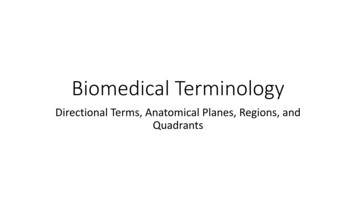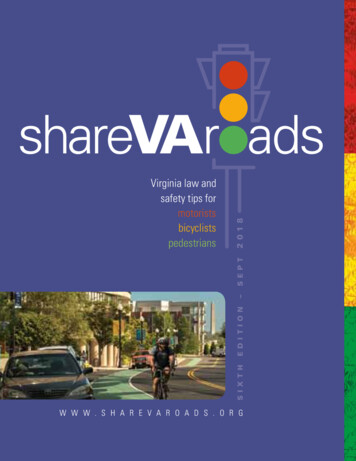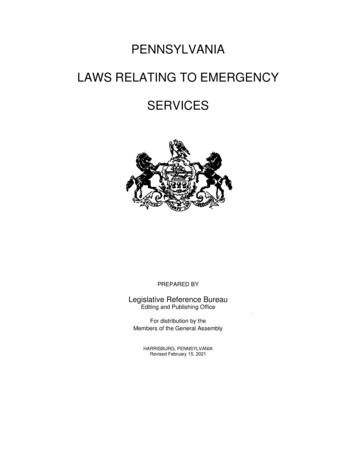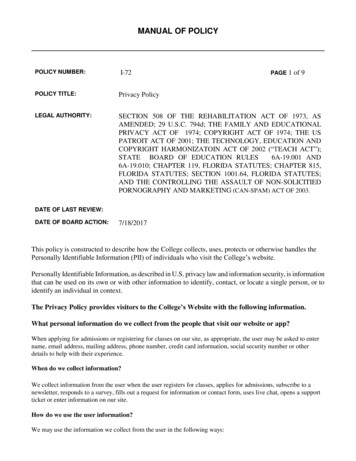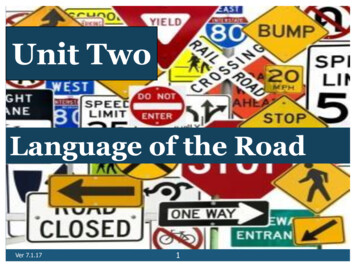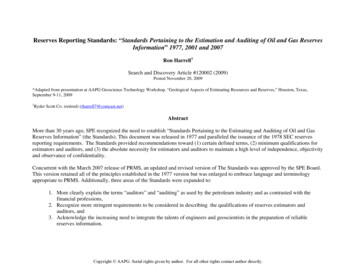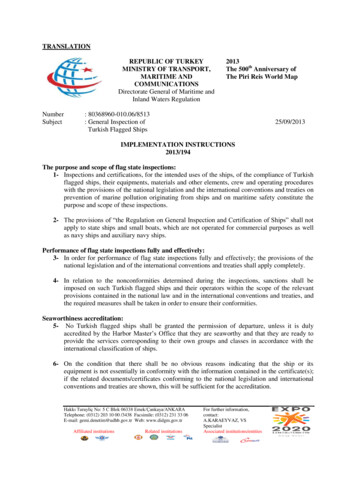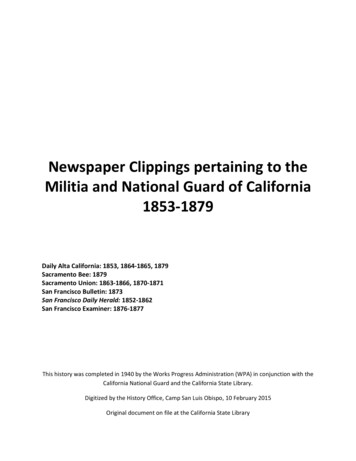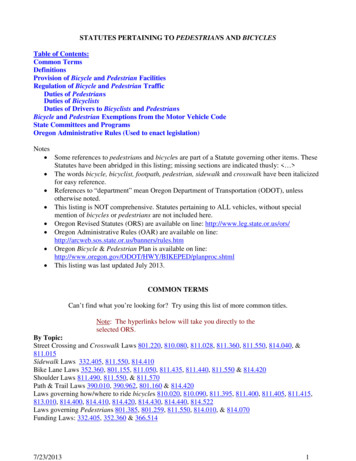
Transcription
STATUTES PERTAINING TO PEDESTRIANS AND BICYCLESTable of Contents:Common TermsDefinitionsProvision of Bicycle and Pedestrian FacilitiesRegulation of Bicycle and Pedestrian TrafficDuties of PedestriansDuties of BicyclistsDuties of Drivers to Bicyclists and PedestriansBicycle and Pedestrian Exemptions from the Motor Vehicle CodeState Committees and ProgramsOregon Administrative Rules (Used to enact legislation)Notes Some references to pedestrians and bicycles are part of a Statute governing other items. TheseStatutes have been abridged in this listing; missing sections are indicated thusly: The words bicycle, bicyclist, footpath, pedestrian, sidewalk and crosswalk have been italicizedfor easy reference. References to “department” mean Oregon Department of Transportation (ODOT), unlessotherwise noted. This listing is NOT comprehensive. Statutes pertaining to ALL vehicles, without specialmention of bicycles or pedestrians are not included here. Oregon Revised Statutes (ORS) are available on line: http://www.leg.state.or.us/ors/ Oregon Administrative Rules (OAR) are available on tm Oregon Bicycle & Pedestrian Plan is available on oc.shtml This listing was last updated July 2013.COMMON TERMSCan’t find what you’re looking for? Try using this list of more common titles.Note: The hyperlinks below will take you directly to theselected ORS.By Topic:Street Crossing and Crosswalk Laws 801.220, 810.080, 811.028, 811.360, 811.550, 814.040, &811.015Sidewalk Laws 332.405, 811.550, 814.410Bike Lane Laws 352.360, 801.155, 811.050, 811.435, 811.440, 811.550 & 814.420Shoulder Laws 811.490, 811.550, & 811.570Path & Trail Laws 390.010, 390.962, 801.160 & 814.420Laws governing how/where to ride bicycles 810.020, 810.090, 811.395, 811.400, 811.405, 811.415,813.010, 814.400, 814.410, 814.420, 814.430, 814.440, 814.522Laws governing Pedestrians 801.385, 801.259, 811.550, 814.010, & 814.070Funding Laws: 332.405, 352.360 & 366.5147/23/20131
Bicycle Equipment Laws811.405, 814.400, 814.484, 814.485, 814.486, 814.487, 814.488, 814.489, 815.052, 815.280, &815.281Alphabetical:Banning Bicyclists and Pedestrians from Freeways 810.020Bicycle Bill 366.514Bicycle Lane 811.028, 811.050, 811.435, and 811.440Bicycle Lights, brakes, etc. 815.280, 811.405Bicycle Racing 810.090Bicycle Safe Drainage grates 810.150Bicycles on Sidewalks 814.410Bicycle is a Vehicle 814.400Construction Activities in the Right-of-way 374.307 and 374.320Crosswalk Definition 801.220 (see fig 69, pg 105 in the Oregon Bicycle and Pedestrian Plan)Crosswalk, establishing or closing 810.080Drunk Bicycling 813.010Hand Signals 811.335, 811.395, 811.400, 811.405, 811.415, 814.440, and 814.522Helmet Laws 814.484, 814.485, 814.486, 814.487, 814.488, 814.489, 815.052 and 815.281Hitchhiking 814.070Mid-block street crossing 814.040Obeying Crossing Guards 811.015Parking in bike lane, crosswalk or sidewalk 811.550Pass on the Right 811.415 (modified effective 1 Jan ’06)Person in a Wheelchair is a Pedestrian 801.385Recreational trails 390.010 and 390.962Ride on Right 814.430Segway 801.259 and 811.550Shared Use path 801.155Shoulder 811.490, 811.550, and 811.570Stopping for Pedestrians in Crosswalks 811.360 & refers to 811.028 (modified effective 1 Jan ’06)Traffic lights and Pedestrians 814.010Use of school parking fines to finance bike lanes and bike parking 352.360Use of school transportation funds to build sidewalks 332.405Where to walk when there’s no sidewalk 814.070Walking against traffic 814.070DEFINITIONSNote: the following are official legal definitions; they may differ from definitions used in engineeringdesign manuals.801.150 "Bicycle." "Bicycle" means a vehicle that:(1) Is designed to be operated on the ground on wheels;(2) Has a seat or saddle for use of the rider;(3) Is designed to travel with not more than three wheels in contact with the ground;(4) Is propelled exclusively by human power; and(5) Has every wheel more than 14 inches in diameter or two tandem wheels either of which is morethan 14 inches in diameter. [1983 c.338 §22]7/23/20132
801.155 "Bicycle lane." "Bicycle lane" means that part of the highway, adjacent to the roadway,designated by official signs or markings for use by persons riding bicycles except as otherwisespecifically provided by law. [1983 c.338 §23]801.160 "Bicycle path." "Bicycle path" means a public way, not part of a highway, that is designatedby official signs or markings for use by persons riding bicycles except as otherwise specificallyprovided by law. [1983 c.338 §24]801.220 "Crosswalk." (see fig 69, pg 105 in the Oregon Bicycle and Pedestrian Plan) "Crosswalk"means any portion of a roadway at an intersection or elsewhere that is distinctly indicated forpedestrian crossing by lines or other markings on the surface of the roadway that conform in design tothe standards established for crosswalks under ORS 810.200. Whenever marked crosswalks have beenindicated, such crosswalks and no other shall be deemed lawful across such roadway at thatintersection. Where no marked crosswalk exists, a crosswalk is that portion of the roadway describedin the following:(1) Where sidewalks, shoulders or a combination thereof exists, a crosswalk is the portion of aroadway at an intersection, not more than 20 feet in width as measured from the prolongation of thelateral line of the roadway toward the prolongation of the adjacent property line, that is includedwithin:(a) The connections of the lateral lines of the sidewalks, shoulders or a combination thereof onopposite sides of the street or highway measured from the curbs or, in the absence of curbs, fromthe edges of the traveled roadway; or(b) The prolongation of the lateral lines of a sidewalk, shoulder or both, to the sidewalk or shoulder onthe opposite side of the street, if the prolongation would meet such sidewalk or shoulder.(2) If there is neither sidewalk nor shoulder, a crosswalk is the portion of the roadway at anintersection, measuring not less than six feet in width, that would be included within the prolongationof the lateral lines of the sidewalk, shoulder or both on the opposite side of the street or highway ifthere were a sidewalk. [1983 c.338 §36]801.258 “Electric assisted bicycle.” “Electric assisted bicycle” means a vehicle that:(1) Is designed to be operated on the ground on wheels;(2) Has a seat or saddle for use of the rider;(3) Is designed to travel with not more than three wheels in contact with the ground;(4) Has both fully operative pedals for human propulsion and an electric motor; and(5) Is equipped with an electric motor that:(a) Has a power output of not more than 1,000 watts; and(b) Is incapable of propelling the vehicle at a speed of greater than 20 miles per hour on levelground. [1997 c.400 §2; 1999 c.59 §233]801.259 “Electric personal assistive mobility device.” “Electric personal assistive mobility device”means a device that:(1) Is self-balancing on two non tandem wheels;(2) Is designed to transport one person in a standing position;(3) Has an electric propulsion system; and(4) Has a maximum speed of 15 miles per hour. [2003 c.341 §2]801.345 “Moped.” “Moped” means a vehicle, including any bicycle equipped with a power source,other than an electric assisted bicycle as defined in ORS 801.258 or a motor assisted scooter as definedin ORS 801.348, that complies with all of the following:(1) It is designed to be operated on the ground upon wheels.(2) It has a seat or saddle for use of the rider.(3) It is designed to travel with not more than three wheels in contact with the ground.(4) It is equipped with an independent power source that:7/23/20133
(a) Is capable of propelling the vehicle, unassisted, at a speed of not more than 30 miles per houron a level road surface; and(b) If the power source is a combustion engine, has a piston or rotor displacement of 35.01 to 50cubic centimeters regardless of the number of chambers in the power source.(5) It is equipped with a power drive system that functions directly or automatically only and doesnot require clutching or shifting by the operator after the system is engaged. [1983 c.338 §59; 1985c.16 §19; 1997 c.400 §5; 2001 c.749 §25]801.348 “Motor assisted scooter.” “Motor assisted scooter” means a vehicle that:(1) Is designed to be operated on the ground with not more than three wheels;(2) Has handlebars and a foot support or seat for the operator’s use;(3) Can be propelled by motor or human propulsion; and(4) Is equipped with a power source that is incapable of propelling the vehicle at a speed of greaterthan 24 miles per hour on level ground and:(a) If the power source is a combustion engine, has a piston or rotor displacement of 35 cubiccentimeters or less regardless of the number of chambers in the power source; or(b) If the power source is electric, has a power output of not more than 1,000 watts. [2001 c.749§2]801.385 "Pedestrian." "Pedestrian" means any person afoot or confined in a wheelchair. [1983 c.338§69]801.440 "Right of way" "Right of way" means the right of one vehicle or pedestrian to proceed in alawful manner in preference to another vehicle or pedestrian approaching under such circumstances ofdirection, speed and proximity as to give rise to danger of collision unless one grants precedence to theother. [1983 c.338 §81]801.450 “Roadway.” “Roadway” means the portion of a highway that is improved, designed orordinarily used for vehicular travel, exclusive of the shoulder. In the event a highway includes two ormore separate roadways the term “roadway” shall refer to any such roadway separately, but not to allsuch roadways collectively. [1983 c.338 §83]801.451 “Roundabout.” “Roundabout” means an intersection characterized by a circulatory roadway,channelized approaches and yield control of entering traffic. A roundabout encompasses the areabounded by the outermost curb line or, if there is no curb, the edge of the pavement, and includescrosswalks on any entering or exiting roadway. [2001 c.464 §2]801.462 “School zone.” (1) “School zone” means both of the following:(a) A specific segment of highway that is adjacent to school grounds and that is marked by signsdescribed in subsection (2) of this section.(b) A crosswalk that is not adjacent to school grounds and that is marked by signs described insubsection (2) of this section.(2) Signs marking a school zone may include any words, symbols or combination of words andsymbols that gives notice of the presence of the school zone. [2003 c.397 §2]801.480 "Shoulder." "Shoulder" means the portion of a highway, whether paved or unpaved,contiguous to the roadway that is primarily for use by pedestrians, for the accommodation of stoppedvehicles, for emergency use and for lateral support of base and surface courses. [1983 c.338 §88]7/23/20134
801.485 "Sidewalk." "Sidewalk" means the area determined as follows:(1) On the side of a highway which has a shoulder, a sidewalk is that portion of the highway betweenthe outside lateral line of the shoulder and the adjacent property line capable of being used by apedestrian.(2) On the side of a highway which has no shoulder, a sidewalk is that portion of the highway betweenthe lateral line of the roadway and the adjacent property line capable of being used by a pedestrian.[1983 c.338 §89]801.524 “Throughway.” “Throughway” means every highway, street or roadway in respect to whichowners or occupants of abutting lands and other persons have no legal right of access to or from thesame except at such points only and in such manner as may be determined by the road authority havingjurisdiction over the highway, street or roadway. [Formerly 801.535]383.003 Definitions for ORS 383.003 to 383.027. As used in ORS 383.003 to 383.027: abridged (5) “Tollway” means any roadway, path, highway, bridge, tunnel, railroad track, bicycle pathor other paved surface or structure specifically designed as a land vehicle transportation route, theconstruction, operation or maintenance of which is wholly or partially funded with toll revenuesresulting from an agreement under ORS 383.005. [1995 c.668 §2]801.590 “Vehicle.” “Vehicle” means any device in, upon or by which any person or property is or maybe transported or drawn upon a public highway and includes vehicles that are propelled or powered byany means. “Vehicle” does not include a manufactured structure. [1983 c.338 §109]Note: The amendments to 801.590 by section 94, chapter 655, Oregon Laws 2003, becomeoperative May 1, 2005. See section 147, chapter 655, Oregon Laws 2003. The text that is operative onand after May 1, 2005, is set forth for the user’s convenience.801.608 Defines the term “vulnerable user of a public way”to mean a pedestrian, a highway worker, a person riding an animal or a person operating anyof the following on a public way, crosswalk or shoulder of the highway:(1) A farm tractor or implement of husbandry.(2) A skateboard.(3) Roller skates.(4) In-line skates.(5) A scooter.(6) A bicycle.THE PROVISION OF BICYCLE & PEDESTRIAN FACILITIES223.880 Public roads included in sidewalk improvement district; assessment on propertybenefited. Any incorporated city, in addition to powers granted by law or charter, may include in anysidewalk improvement district within the city all county roads or state highways or any part thereofwhich are located within the improvement district. It may cause to be built on the county roads or statehighways or portions thereof within the improvement district, sidewalks for pedestrian travel, and mayassess the cost thereof upon the property benefited thereby, in the manner provided by charter or law.[Formerly 223.850]7/23/20135
276.095 Use of buildings by state and public. (Abridged) With respect to operating, maintaining,altering and otherwise managing or acquiring space to meet the office needs of state government and toaccomplish the purposes of ORS 276.094, the Director of the Oregon Department of AdministrativeServices may: . (2) Provide and maintain space, facilities and activities to the extent practicable that encourage publicaccess to and stimulate public pedestrian traffic around, into and through state buildings, permittingcooperative improvements to and uses of the area between the building and the street, therebycomplementing and supplementing commercial, cultural, educational and recreational resources in theneighborhood of state buildings. [1977 c.599 §3; 1999 c.387 §1]332.405 Transportation; board and room; pedestrian facilities. (Abridged) (1) The district schoolboard shall provide transportation for pupils or combinations of pupils and other persons to and fromschool-related activities where required by law or when considered advisable by the board. . (4)The district school board may expend district funds to improve or provide for pedestrian facilities offdistrict property if the board finds that the expenditure reduces transportation costs of the district andenhances the safety of pupils going to and from schools of the district. [Formerly 338.010; 1981 c.237§1; 1981 c.403 §3; 1993 c.45 §53; 1999 c.961 §4]352.360 Traffic control on properties under state board; enforcement; fees; use. (Abridged) . (4) All fees and charges for parking privileges and violations are hereby continuously appropriated tothe State Board of Higher Education to be used to defray the costs of constructing bicycle racks andbicycle lanes and of traffic control, enforcement of traffic and parking regulations, and maintenanceand operation of parking facilities and for the purpose of acquiring and constructing additional parkingfacilities for vehicles at the various institutions, department or activities under the control of the board,and may also be credited to the Higher Education Bond Sinking Fund provided for in ORS 351.460.Parking fees shall be established at levels no greater than those required to finance the construction,operation and maintenance of parking facilities on the same campus of the institution of the stateinstitution of higher education on which the parking is provided. Notwithstanding ORS 351.072,parking fees or changes in fees shall be adopted by rule of the state board subject to the procedure forrules adopted in ORS 183.310 to 183.550.366.460 Construction of sidewalks within highway right of way. The department may construct andmaintain within the right of way of any state highway or section thereof sidewalks, footpaths, bicyclepaths or trails for horseback riding or to facilitate the driving of livestock. Before the construction ofany of such facilities the department must find and declare that the construction thereof is necessary inthe public interest and will contribute to the safety of pedestrians, the motoring public or persons usingthe highway. Such facilities shall be constructed to permit reasonable ingress and egress to abuttingproperty lawfully entitled to such rights.366.550 “Historic Columbia River Highway” defined. As used in ORS 366.550 to 366.553,“Historic Columbia River Highway” means all parts of the original Columbia River Highway,constructed between 1913 and 1922, in Multnomah, Hood River and Wasco Counties, that have beendesignated as a “Historic and Scenic Highway” under ORS 377.100 and all properties and structuresthat are within the Columbia River Highway Historic District, National Register of Historic Places.[1987 c.382 §1]Note: 366.550 to 366.553 were enacted into law by the Legislative Assembly but were not addedto or made a part of ORS chapter 366 or any series therein by legislative action. See Preface to OregonRevised Statutes for further explanation.366.514 Use of highway fund for footpaths and bicycle trails. (1) Out of the funds received by theDepartment of Transportation or by any county or city from the State Highway Fund reasonableamounts shall be expended as necessary to provide footpaths and bicycle trails, including curb cuts orramps as part of the project. Footpaths and bicycle trails, including curb cuts or ramps as part of theproject, shall be provided wherever a highway, road or street is being constructed, reconstructed or7/23/20136
relocated. Funds received from the State Highway Fund may also be expended to maintain footpathsand trails and to provide footpaths and trails along other highways, roads and streets.(2) Footpaths and trails are not required to be established under subsection (1) of this section:(a) Where the establishment of such paths and trails would be contrary to public safety;(b) If the cost of establishing such paths and trails would be excessively disproportionate to theneed or probable use; or(c) Where sparsity of population, other available ways or other factors indicate an absence of anyneed for such paths and trails.(3) The amount expended by the department or by a city or county as required or permitted by thissection shall never in any one fiscal year be less than one percent of the total amount of the fundsreceived from the highway fund. However:(a) This subsection does not apply to a city in any year in which the one percent equals 250 orless, or to a county in any year in which the one percent equals 1,500 or less.(b) A city or county in lieu of expending the funds each year may credit the funds to a financialreserve fund in accordance with ORS 294.525, to be held for not more than 10 years, and to beexpended for the purposes required or permitted by this section.(c) For purposes of computing amounts expended during a fiscal year under this subsection, thedepartment, a city or county may record the money as expended:(A) On the date actual construction of the facility is commenced if the facility is constructed by thecity, county or department itself; or(B) On the date a contract for the construction of the facilities is entered with a private contractoror with any other governmental body.(4) For the purposes of this chapter, the establishment of paths, trails and curb cuts or ramps andthe expenditure of funds as authorized by this section are for highway, road and street purposes. Thedepartment shall, when requested, provide technical assistance and advice to cities and counties incarrying out the purpose of this section. The department shall recommend construction standards forfootpaths and bicycle trails. Curb cuts or ramps shall comply with the requirements of ORS 447.310and rules adopted under ORS 447.231. The department shall, in the manner prescribed for markinghighways under ORS 810.200, provide a uniform system of signing footpaths and bicycle trails whichshall apply to paths and trails under the jurisdiction of the department and cities and counties. Thedepartment and cities and counties may restrict the use of footpaths and bicycle trails under theirrespective jurisdictions to pedestrians and nonmotorized vehicles, except that motorized wheelchairsshall be allowed to use footpaths and bicycle trails.(5) As used in this section, “bicycle trail” means a publicly owned and maintained lane or waydesignated and signed for use as a bicycle route. [1971 c.376 §2; 1979 c.825 §1; 1983 c.19 §1; 1983c.338 §919; 1991 c.417 §7; 1993 c.503 §12; 1997 c.308 §36; 2001 c.389 §1]366.552 Historic road program for Historic Columbia River Highway; footpaths and bicycletrails; acquisition of property; cooperation with other agencies. (1) The Department ofTransportation and the State Parks and Recreation Department shall prepare and manage a historicroad program, in consultation with the Historic Columbia River Highway Advisory Committee andother affected entities, consistent with the purposes of the Columbia River Gorge National Scenic AreaAct of 1986 and the public policy of this state declared in ORS 366.551.(2) The departments shall inform the advisory committee of those activities of the departments whichmay affect the continuity, historic integrity and scenic qualities of the Historic Columbia RiverHighway.(3) The departments shall undertake efforts to rehabilitate, restore, maintain and preserve all intact andusable segments of the Historic Columbia River Highway and associated state parks. The Departmentof Transportation may expend funds dedicated for footpaths and bicycle trails under ORS 366.514 toconstruct footpaths and bicycle trails on those portions of the Historic Columbia River Highway thatare parts of the state highway system or that are county roads or city streets and the State Parks and7/23/20137
Recreation Department may incorporate those segments into the Oregon recreation trails system underthe provisions of ORS 390.950 to 390.989 and 390.990 (4).(4) The departments may acquire real property, or any right or interest therein, deemed necessary forthe preservation of historic, scenic or recreation qualities of the Historic Columbia River Highway, forthe connection of intact and usable segments, or for the development and maintenance of parks alongor in close proximity to the highway. The departments shall encourage the acquisition of lands, orinterests in lands, by donation, agreement, exchange or purchase.(5) The departments shall assist and cooperate with other agencies and political subdivisions of thestate, state agencies, the Federal Government, special purpose districts, railroads, public and privateorganizations and individuals to the extent necessary to carry out the provisions of ORS 366.550 to366.553. The departments may enter into such contracts as are necessary to carry out these provisions.[1987 c.382 §3; 1989 c.904 §37]Note: See note under 366.550.374.307 Removal or repair of installation constructed without permission. (1) If any person, firmor corporation builds or constructs on the right of way of any state highway or county road anyapproach road or any other facility, thing or appurtenance without first obtaining the writtenpermission required by ORS 374.305, the Department of Transportation or the county governing bodyshall, after the expiration of 30 days following the transmittal of a written notice to such person, firmor corporation, at the expense of such person, firm or corporation, remove all such installations fromthe right of way or reconstruct, repair or maintain any such installation in accordance with or asrequired by the rules and regulations. This expense may be recovered from such person, firm orcorporation by the state or county in any court of competent jurisdiction.(2) Notwithstanding subsection (1) of this section, if the Department of Transportation, countygoverning body or designated agent of the department or governing body, whichever is applicable,determines that a traffic or pedestrian hazard is created by the construction which causes imminentdanger of personal injury, it may:(a) Order the construction removed, repaired or maintained to eliminate the hazard, within 24 hoursafter delivery of written notice to the person, firm or corporation which caused the construction,and to the owner of the property on which the construction occurred.(b) If the hazard is not removed within the time set under paragraph (a) of this subsection, remove thehazard and recover the expenses of any removal, repair or maintenance from any such person, firmor corporation in any court of competent jurisdiction. [1955 c.424 §5; 1979 c.873 §1]374.320 Removal or repair of installation on right of way at expense of applicant. (1) Upon failureof the applicant to construct or maintain the particular approach road, facility, thing or appurtenance inaccordance with the rules and regulations and the conditions of the permit, the Department ofTransportation or the county governing body shall, after the expiration of 30 days following thetransmittal of a written notice to the applicant, at applicant's expense, remove all such installationsfrom the right of way or reconstruct, repair or maintain any such installation in accordance with or asrequired by such rules and regulations and the conditions of such permit. This expense may berecovered from the applicant by the state or county in any court of competent jurisdiction. (2)Notwithstanding subsection (1) of this section, if the Department of Transportation, countygoverning body or designated agent of the department or governing body, whichever is applicable,determines that a traffic or pedestrian hazard is created by the noncompliance which causes imminentdanger of personal injury, it may:(a) Order the construction removed, repaired or maintained to eliminate the hazard, within 24 hoursafter delivery of written notice to the applicant, and to the owner of the property on which thenoncompliance occurred.(b) If the hazard is not removed within the time set under paragraph (a) of this subsection, remove thehazard and recover the expenses of any removal, repair or maintenance from the applicant in any courtof competent jurisdiction. [Amended by 1955 c.424 §3; 1979 c.873 §2]376.605 Construction of trails and bridle paths to Pacific shore. [Amended by 1971 c.741 §26;repealed by 2001 c.388 §1]7/23/20138
381.088 Tolls and franchise fees. The Department of Transportation may impose and collect tolls andfranchise fees for the use of said bridge by all vehicles, pedestrians, public utilities andtelecommunications utilities, including power, light, telephone and telegraph wires, and water, gas andoil pipes. [1953 c.389 §2; 1987 c.447 §123]383.013 Tollway design. abridged (1) The design of each tollway shall at least meet the minimumdesign standards generally applicable, at the time the Department of Transportation authorizes thetollway, to the state and other units of government authorized to build and own roads, highways,bridges, tunnels, railways and related facilities. (3) In considering the design of a tollway, the department shall solicit the recommendation ofstate and local parks departments to consider whether parks or campsites for travelers or bicyclistsshould be incorporated into the tollway design. The department may enter into agreements for the useof state and local funding for the acquisition and construction of such parks and campsites. The land onwhich such parks and campsites shall be located may be owned or leased in any manner in which anyother tollway property may be owned or leased and shall be managed by any entity chosen by thedepartment for such purpose, including the entity that operates or maintains the tollway. The allocationof revenues derived from the ownership or operation of any park or campsite shall be in accordancewith any arrangement the department deems desirable. [1995 c.668 §6; 2001 c.844 §3]390.010 Policy of state toward outdoor recreation resources. The Legislative Assembly recognizesand declares:(1) It is desirable that all Oregonians of present and future generations and visitors who are lawfullypresent within the boundaries of this state be assured adequate outdoor recreation resources. It isdesirable that all levels of government and private interests take prompt and coordinated action to theextent practicable without diminishing or affecting their respective powers and functions to conserve,develop, and utilize such resources for the benefit and enjoyment of all the people.(2) The economy and well-being of the people are in large part dependent upon proper utilization ofthe state's outdoor recreation resources for the physical, spiritual, cultural, scientific and other benefitswhich such resources afford.(3) It is in the public interest to increase outdoor recreation opportunities commensurate with thegrowth in need through necessary and appropriate actions, including, but not limited to, the following: . (h) Provision of trails for horseback riding, hiking, bicycling and motorized trail vehicle riding. . (5) It shall be the policy of the State of Oregon to supply those outdoor recreation areas, facilities andopportunities which are clearly the responsibility of the state in meeting growi
801.345 "Moped." "Moped" means a vehicle, including any bicycle equipped with a power source, other than an electric assisted bicycle as defined in ORS 801.258 or a motor assisted scooter as defined in ORS 801.348, that complies with all of the following: (1) It is designed to be operated on the ground upon wheels.
